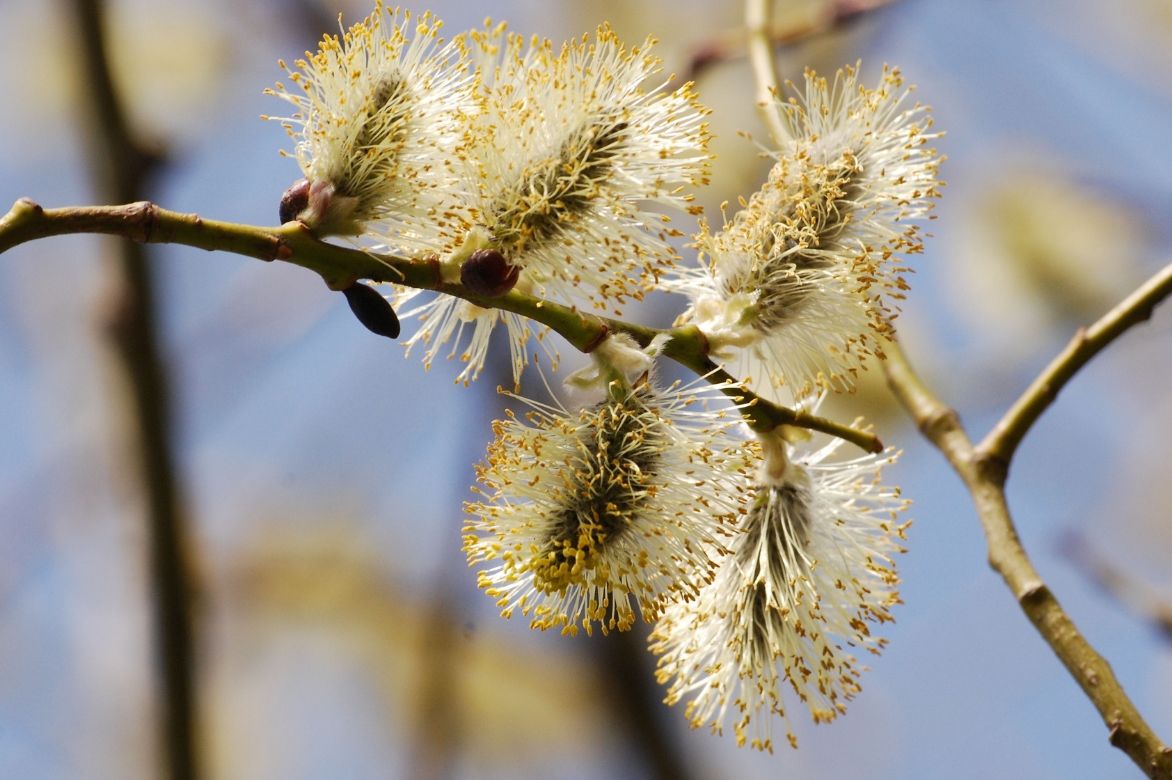
Willow, Salix: planting, pruning and care
Contents
Willows, in a nutshell
- The willow family offers a great diversity ranging from the imposing and romantic weeping willow to the small creeping subject, including the elegant shrimp willow trained on a stem with soft pink foliage.
- Very hardy, willows grow with great ease and quickly, forming remarkable specimens in just a few years that can be easily multiplied.
- Willows appreciate cool soils, even waterlogged for most, and a sunny exposure.
- They tolerate annual pruning but can also grow freely to express their weeping or twisted silhouette.
A word from our expert
Willows, Salix in Latin, are very easy to grow and can withstand Siberian temperatures, much like the birch found up to the Arctic Circle. They include large trees with a bushy habit reaching up to 20 m in height, sometimes weeping, down to the prostrate creeping undershrub. Thus, we can distinguish large trees with a natural and wild appearance such as the goat willow, the weeping willows that are so romantic when their fresh green drooping branches sweep across the water’s surface and the ornamental varieties suited to modest gardens, often overlooked, like Salix gracilistyla, Salix Mount Aso, and Golden Sunshine, remarkable for their silky coloured aments, their habit, or their colourful foliage.
Let’s not forget the “useful” varieties like the basket willow, perfect for creating a wild hedge from which one can harvest long, flexible, and colourful branches for weaving living hedges and other wickerwork items. Willow bark is also well-known for having provided the medicine Aspirin, an excellent antipyretic and pain reliever that thins the blood, even though the molecule salicin is now synthesised and replaced by acetylsalicylic acid.

Willow aments
These are deciduous trees among the first to bud in spring and the last to lose their leaves. With three hundred species ranging from large park trees like the weeping willow to the prostrate undershrub with an upright, twisted habit like Salix matsudana ‘Tortuosa’ or bushy, with silver or pink variegated foliage like the shrimp willow, this genus offers a diversity often unsuspected that also allows it to fit into small gardens. Those we are familiar with, such as the white willow Salix alba or the goat willow, have been cultivated for their ornamental qualities, for their flexible wood used in wickerwork, or for their effective suckering character that stabilises riverbanks. All willows bear flowers in male or female aments on distinct subjects, with narrow leaves, and they share a preference for fresh to waterlogged soils and sunny exposures. They are appreciated for their rapid growth, their ornamental qualities that often make them interesting throughout the year, as well as for their ease of cultivation. It is not widely known, but some species and varieties are adapted to montane climates or even the Mediterranean Midi.
Description and Botany
Botanical data
- Latin name Salix sp.
- Family Salicaceae
- Common name Willow, Osier
- Flowering between February and May
- Height between 50 cm and 25 m
- Sun exposure sun or partial shade
- Soil type any rather cool to waterlogged soil
- Hardiness Excellent (-40°C to -30°C)
The Willow is part of the Salicaceae family, just like the Poplar, and primarily inhabits the temperate to cold and rather humid regions of the northern hemisphere. Willow shrubs are pioneering species capable of forming a monospecific thicket in areas disturbed by cutting or fire, while tree willows like the goat willow often associate with other forest species.
The family, initially consisting of 2 or 3 genera, has expanded to include a significant portion of the Flacourtiaceae family, now counting a total of 55 genera, following the APG II phylogenetic classification (2003). Nearly 400 species are currently recorded in the Salix genus, with spontaneous hybridizations between these species being common – including polyploids, with up to 6 sets of chromosomes – and easily obtained artificially. The greatest diversity of Salix is found in China, followed by North America (100 species) and Europe (70 species). Identification often relies on flowering and fruiting.
The weeping willow is the most iconic representative of the genus, having been part of the European landscape for over two centuries. It is generally planted by bodies of water and in the lawns of large parks, although its longevity is quite low. Several species constitute the family of weeping willows, knowing that the original Chinese species Salix babylonica has given way to more robust hybrids like Salix x sepulcralis ‘Chrysocoma’, the most widespread, created in Berlin in 1888 and awarded the Award of Garden Merit by the Royal Horticultural Society in 1984. It is the result of an artificial hybridization between Salix alba ‘Vitellina’, hardy with yellow branches, and Salix babylonica ‘Babylon’, responsible for its weeping habit and which has also imparted its resistance to high temperatures, so it is not surprising to find Salix x sepulcralis ‘Chrysocoma’ even in tropical regions!
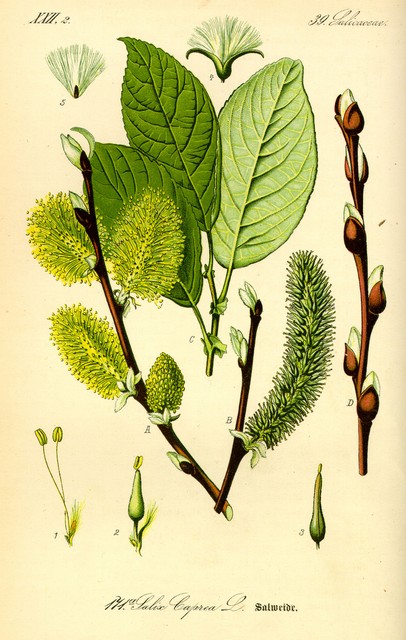
Salix caprea – botanical illustration
Willow leaves are deciduous, alternate, and simple, pointed at the tip. The lamina, 2 to 10 times longer than wide and borne on a short petiole, has entire or finely dentate edges. The foliage colour varies from the grey-green of goat willow to the bright green of weeping willows, passing through the golden tones of the cultivar Salix sachalinensis ‘Golden Sunshine’. The white willow (Salix alba) is recognized by the white and silky underside of the lamina. The base of the petiole is often accompanied by two stipules that are more or less persistent, leaving a V-shaped leaf scar after the leaf falls. The dimensions of the leaves, teeth, and stipules can sometimes be larger on the vigorous shoots of the plant. The buds are quite characteristic in willows as the terminal bud is absent due to the abortion of the tips of the branches, and the lateral buds covered by a single scale are applied against the branch.
The thin branches of the year display various colours: green (Salix viminalis), brown (Salix triandra), black (Salix daphnoides ‘Aglaia’), yellow (Salix alba subsp. vitellina), orange (Salix alba ‘Britzensis’), purple (Salix purpurea), or red (Salix fragilis) which basket makers appreciate. Willow producers prune every year between the first frosts of October and March the shoots of the year to encourage regrowth of over 1.50 m (wicker rods), resulting in the strange hairy silhouettes of pollarded willows typical of humid bocage areas.
The male and female flowering usually occurs on different subjects in the form of drooping or erect male catkins and erect female catkins. Some hybrids, like our famous weeping willow, are hermaphrodites. The male catkins have significant ornamental interest in certain species, well known in the cultivar Salix caprea Kilmarnork with its silky and ash-like appearance. New species and cultivars are sure to attract originality enthusiasts, such as Salix chaenomeloides Mount Aso with its 2.5 cm red-pink catkins or Salix hastata Wehrhahnii with numerous ovoid catkins that are initially silver and silky, elongating to measure up to 7 cm long, releasing many cream-yellow stamens. This flowering is well appreciated by bees that come to seek pollen and nectar sometimes as early as February, as with goat willow (Salix caprea). In weeping willows, flowering appears after leafing, so its ornamental interest remains quite limited. The greenish or yellowish flowers grouped in spikes have neither sepals nor petals but are preceded by a pubescent entire bract and accompanied by nectariferous glands. Pollination occurs both by wind and insects due to the characteristics of its thick and waxy pollen and its nectar. The willow constitutes a significant food source for pollinating insects, unlike the poplar, which is adapted solely for the wind dispersal of its naked pollen.
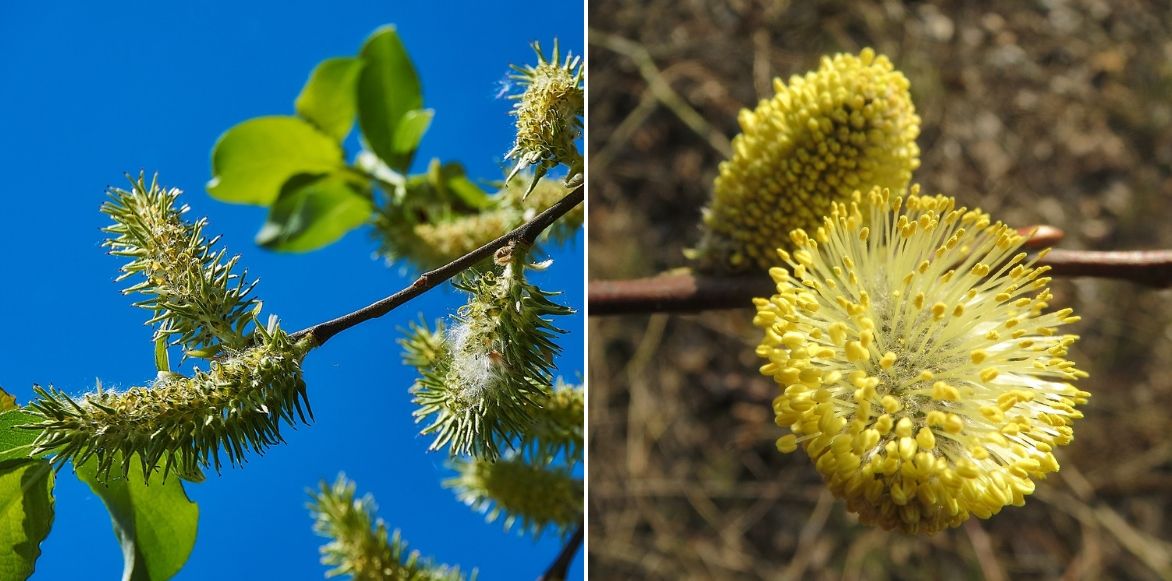
Salix caprea: difference between female catkins (left) and male catkins (right)
The fruits borne by female trees are 2-valved capsules that release green seeds bearing a white silky egret, dispersed by water or wind.
Although willow wood is not very durable, it is shock-resistant, lightweight, and homogeneous with a straight grain, making it suitable for making tool handles, boxes, or paper pulp, just like poplar. Their ability to sucker allows willows to stabilise banks.
The Latin name Salix designated the willow among the Romans.
The willow is laden with symbols, particularly in Tibet, where it evokes life, and in China, where it embodies immortality.

Willows exhibit a diversity of foliage: Salix alba, Salix integra ‘Hakuro Nishiki’ (Shrimp Willow), Salix sachalinensis ‘Golden Sunshine’, Salix lanata
Read also
How to make a living willow hut?The main varieties of Salix
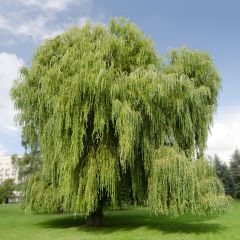
Salix alba Tristis - White Willow
- Flowering time May, June
- Height at maturity 20 m
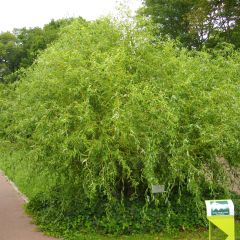
Salix x erythroflexuosa - Willow
- Flowering time April, May
- Height at maturity 4 m
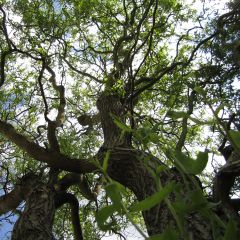
Salix matsudana Tortuosa - Dragon's Claw Willow
- Flowering time May, June
- Height at maturity 10 m
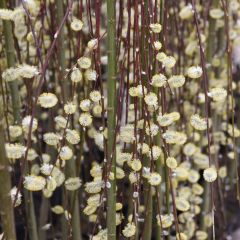
Salix caprea Kilmarnock - Great Sallow
- Flowering time March, April
- Height at maturity 3 m
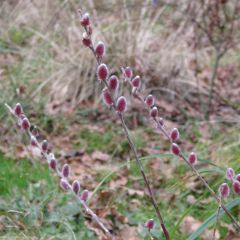
Salix gracilistyla Mount Aso - Black Willow
- Flowering time March to May
- Height at maturity 3 m

Salix gracilistyla - Black Willow
- Flowering time April
- Height at maturity 2 m
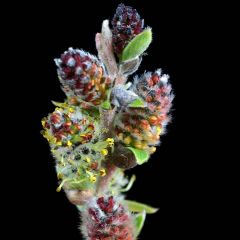
Salix subopposita - Willow
- Flowering time April, May
- Height at maturity 1 m
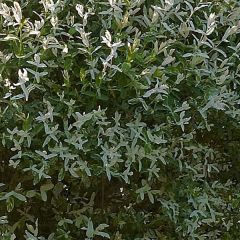
Salix integra Hakuro-Nishiki - Flamingo Willow
- Flowering time April, May
- Height at maturity 1,50 m
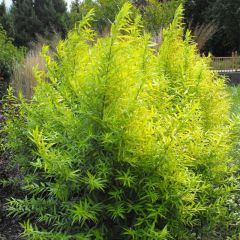
Salix sachalinensis Golden Sunshine - Sachalin Willow
- Flowering time April, May
- Height at maturity 4 m
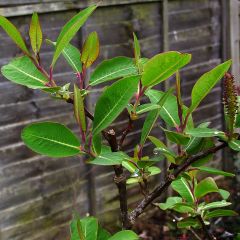
Salix magnifica - Willow
- Flowering time April, May
- Height at maturity 7 m
Discover other Willow - Salix
View all →Available in 1 sizes
Available in 1 sizes
Available in 1 sizes
Available in 1 sizes
Available in 1 sizes
Available in 1 sizes
Available in 1 sizes
Available in 1 sizes
Available in 2 sizes
Available in 2 sizes
Young plantation
Where to Plant Willow?
In general, willows prefer a cool to moist soil, but they can also thrive in ordinary soil and will adapt to both light, stony, sandy soils and heavy, clayey, very wet soils. Most of them tolerate the presence of lime as well as sandy or slightly acidic soils and can withstand temporary flooding, while others can cope with dry conditions in summer with occasional generous watering, such as the coyote willow. Their tolerance to Siberian cold allows them to be planted in both plains and mountains, but they fear scorching summers.
Plant weeping willows, which are large trees, at a distance from buildings (at least 15 m) to prevent their roots from damaging pipes in search of water. Choose a non-paved location, a meadow, or the banks of a stream or pond.
A sunny or slightly shaded location is suitable for all willows.
Weeping willows can tolerate harsh winters (-40 °C) as well as tropical climates.
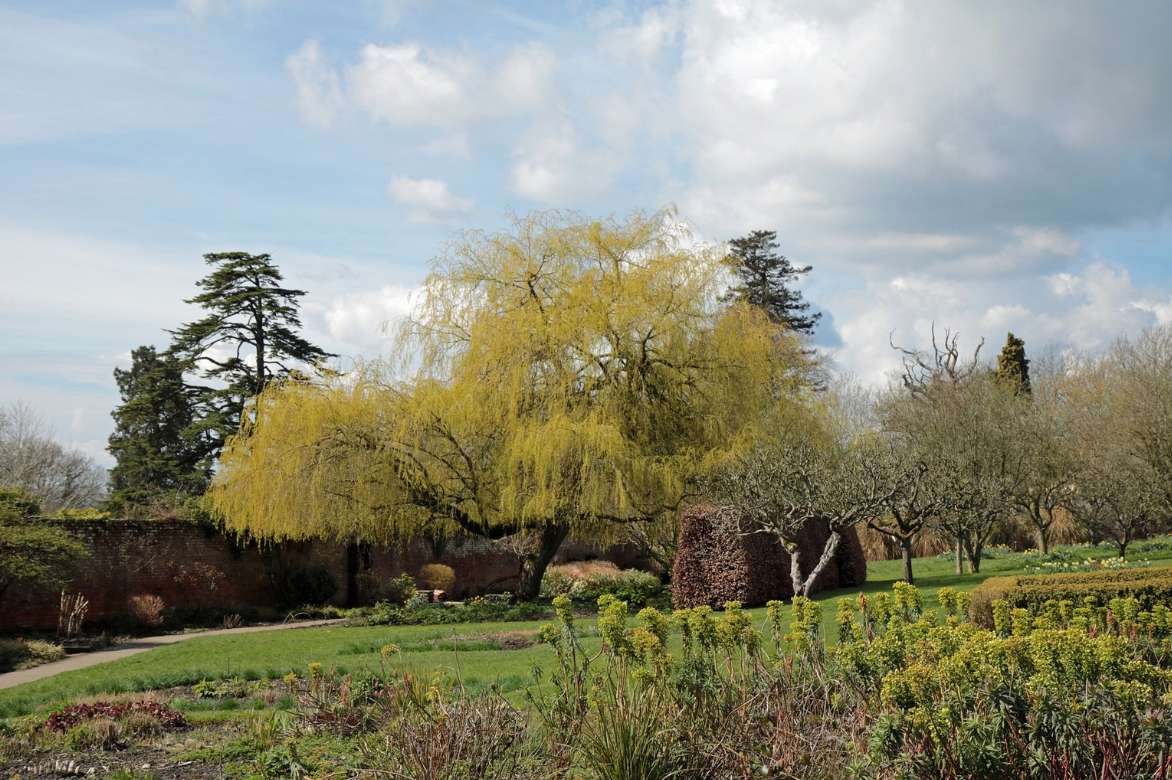
When to Plant?
Plant willows preferably in autumn to ensure deep rooting before facing summer drought.
How to Plant?
-
- Soak the root ball in a bucket of water to thoroughly moisten it.
- Dig a planting hole 60 cm wide for large willows, 40 cm for shrub types, or a trench 50 cm wide for a hedge. Shrub willows can be spaced 1 to 2 m apart depending on their vigor and the extent you wish to give each bush. You can always plant a cutting in the ground to thicken the hedge!
- Add a good amount of compost or potting soil to your garden soil if it is poor.
- Place the plant in the planting hole after untangling any roots that may have circled in the pot.
- Replace the soil and lightly compact it to form a basin.
- Water.
- Spread a layer of mulch at the base to maintain good moisture around the roots. This will also limit the growth of weeds.
The recovery is very easy and quick, requiring only monitoring of watering during the first 2 years after planting.
Read also
How to make a wicker plant support?Pruning and maintenance of willow
Water regularly for the first two years, especially during hot and dry periods. This bush requires no other maintenance, except for pruning if necessary, which should be light and carried out after flowering.
Pruning Willows
Decorative willows for their aments (Salix caprea, alba …)
They benefit from being pruned every year or every 2-3 years to achieve long shoots bearing buds and to maintain a compact size. Take this opportunity to collect shoots with buds for floral decoration. Flower buds form on one-year-old wood, so pruning should not occur in winter, but just after flowering (except for the shoots intended for bouquets) to direct the sap towards a limited number of vegetative buds. The cut can be made at the same place, resulting in “pollarded” willows or “willow heads” with large swellings, or after the 1st bud of the last shoot. Avoid damaging or removing the swellings, as they contain a significant portion of the tree’s reserves.
Ingrid explains in our tutorial: When and how to prune the shrimp willow?
How to prevent the leaves of the shrimp tree from drying out in summer?
Willows for basketry (Salix viminalis, triandra, purpurea, alba…)
- Prune at the same place every year the willow shoots after leaf fall and before the resumption of growth. The cut can be made at ground level to facilitate mechanical cutting or 50 cm or more above the ground to form the trunk of a pollarded tree.
- Form homogeneous bundles and keep the living shoots by soaking their bases in 10 cm of water. If the shoots are not kept alive, their bark will turn brown and wilt after 3-4 years. This is why the shoots are sometimes treated in an autoclave to prolong their outdoor viability.
- Fully submerge the shoots in water for 8 to 10 days before weaving to soften them. The weaving of living shoots should be done between December and April.
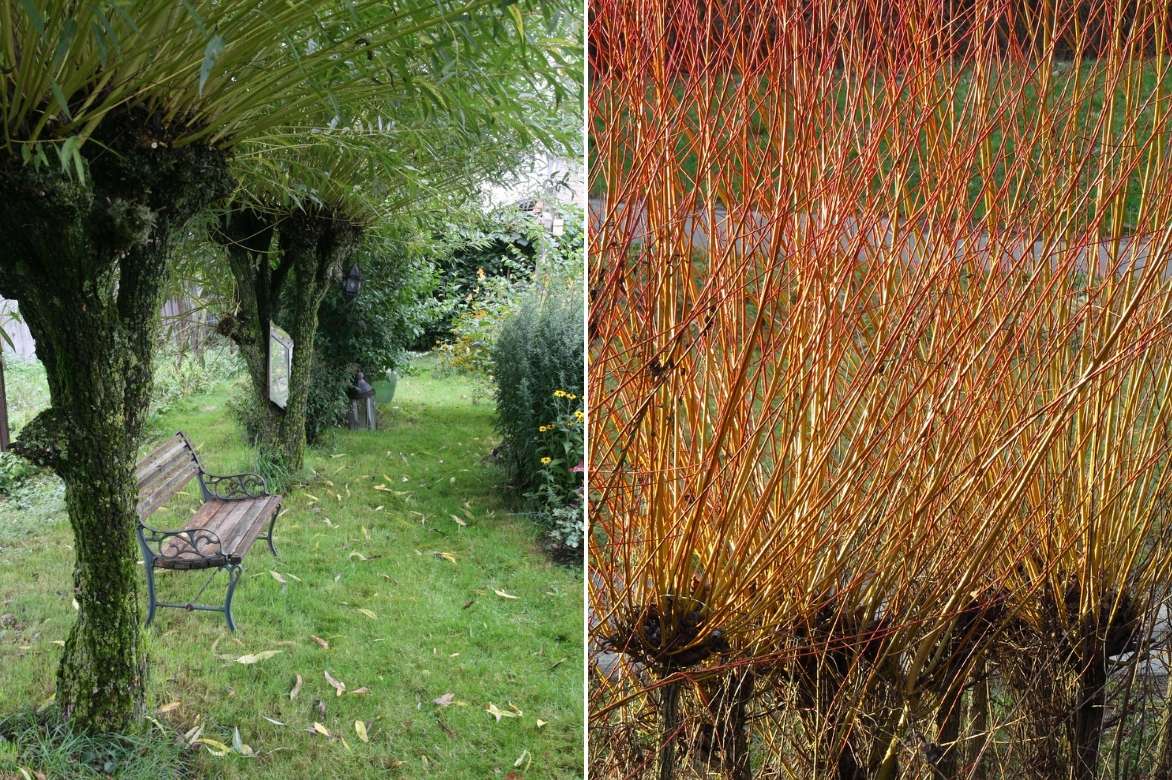 Basket willows
Basket willows
White willow is dry and only needs a few hours of soaking to soften: the shoots kept alive until the resumption of growth in May have been stripped of their bark, giving them this light colour.
To learn more about basketry
Weeping and twisted willows (Salix chrysocoma, sepulcralis, babylonica)
Pruning is important at the start to ensure the trunk gains sufficient height before allowing its branches to droop. A plant left to its own devices will form a tree twice as wide as it is tall.
Be aware that willows do not tolerate large diameter cuts (over 5 cm) well, as they heal poorly, leading to heart rot. The light wood is then less able to support weight and breaks easily, which is why tree formation should begin at a young age. Apply the following pruning technique to gradually raise the crown:
-
- When the trunk exceeds about 2.20 m, select the 5 or 6 branches that will serve as the starting point for the crown.
-
- At the end of winter, prune them just above a bud located at the top of the curve (30-40 cm from its base).
-
- Remove the others at the trunk level.
-
- Repeat the same operation on the new shoots in subsequent years to raise the crown in overlapping arcs.
-
- In parallel, remember to remove all weak branches, those that cross, and those with cankers (disinfect the pruning shear between each cut).
Potential Diseases and Pests
Willows are generally quite robust if they do not suffer from stress due to lack of water or severe pruning.
The foliage is sometimes subject to anthracnose, which causes black spots surrounded by yellow on the leaves and shoots in spring and summer. Leaves fall, and cankers form, preventing sap flow. Scab leads to black spots on the underside of leaves and then on young leaves, causing shoots to bend and dry out, covered in black lesions. Black canker also causes leaf spots and cankers.
In all three cases, collect and burn fallen leaves on the ground and quickly prune diseased shoots. Spray a fungicide once a month from March if the attack recurs.
caterpillars and aphids followed by sooty mould deposits can affect young plants and may require insecticidal treatment (pyrethrin…). Most of the time, no intervention is needed.
→ Learn more about willow diseases and pests
Multiplication: propagation by cuttings
Propagation by cuttings
It is the simplest and most effective way to multiply willows. Cut branches of any size and plant them in loosened soil, then water. Rooting is very quick, making the formation of a hedge of small willows very easy to achieve!
→ Learn more about the propagation by cuttings of willow in our tutorial!
Uses and associations
There is such a diversity of shapes, sizes, and cultural requirements among willows that it is impossible not to find a specimen that will thrive in your garden. A willow always brings a bucolic and natural touch, sometimes very original, romantic, or even elegant, depending on the varieties.
Weeping or twisted willows benefit from being planted in isolation in the middle of a short grass meadow or on the banks of a pond colonised by water lilies or lotuses, or by a river. The silhouette of these trees inspired many poets and romantic writers such as Alfred de Musset, as well as painters like Monet, who see in this shape a kind of melancholic evocation. Their dimensions can be extremely variable (7 to 20 m) depending on the cultivar and water availability. Be sure to gather information from your nurseryman before planting a willow, as it can be difficult to remove if it becomes troublesome. The lifespan of a weeping willow can reach around a hundred years. It can form a beautiful ensemble on the banks of a pond or lake alongside Bald Cypress, Liquidambars, Tulip Trees, Nyssa sylvatica, and Gunnera, which require the same moist conditions.

Majestic weeping willow on the edge of a pond
The white willow (Salix alba), capable of reaching 25 m in height, makes an excellent windbreak, shimmering with its silver-backed foliage. It has given rise to several cultivars with coloured wood used in basketry, such as Britzensis and Vitellina, which can be trained as low pollarded trees.
Small and medium willows ranging from 1 to 7 m in height, decorative for their coloured bark, foliage, or aments in spring, can form rustic hedges that can be cut back as desired. They are also delightful in a mass planting alongside a Beech, Hazel, Witch Hazel, and a Physocarpus with purple or golden foliage. To add a touch of lightness to the scene and enhance it with warm tones in summer and autumn, plant clumps of Miscanthus or Panicum in the foreground. By a large body of water, plant them alongside dogwoods with coloured bark (Cornus sanguinea, Cornus sericea), Miscanthus, Gorse, or Bulrushes. Create a floral tableau in a bohemian chic style in white and gold, with a backdrop of an ornamental apple Malus Golden Hornet, then Salix sachalinensis Golden Sunshine, an Itea virginica Henry’s Garnett or Little Henry’s, and in the foreground, a few clumps of Ligularias.
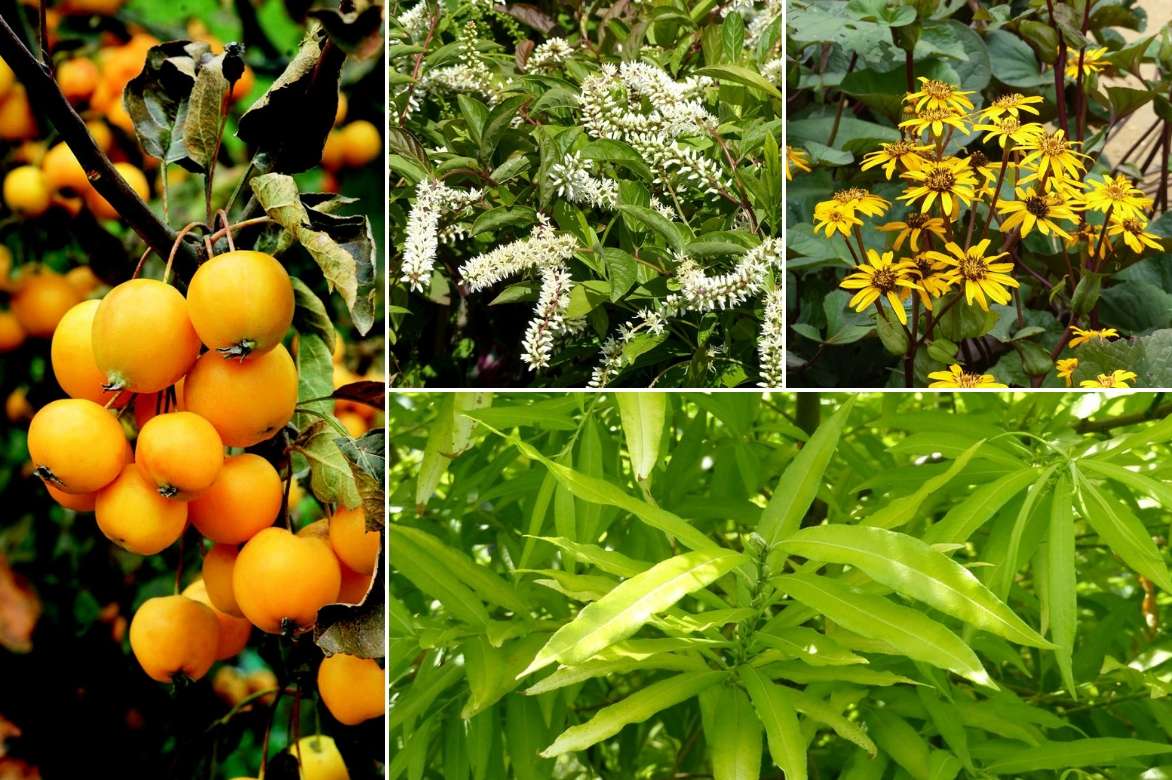
An idea for a white and gold association: Malus ‘Golden Hornet’ (©Horticolor Lyon), Itea virginica ‘Little Henry’s’, Salix sachalinensis ‘Golden Sunshine’ and Ligularia dentata ‘Britt-Marie Crawford’
To create a rainbow hedge, simply introduce different willows with coloured foliage such as the shrimp willow for pink and cream, Salix rosmarinifolia for silver-grey, Salix sachalinensis Golden Sunshine for gold, not forgetting the magnificent willow (Salix magnifica) for its jade tones…
In a rockery with deep clay soil, install the dwarf Japanese willow, Salix subopposita, with bonsai-like features. This compact shrub, with slow growth, reaching 1 m in height and 1.20 m in width, is covered with silver aments, then golden in March-April, before the appearance of the soft, grey-blue-green, downy foliage. It also forms lovely ground-cover borders, adorns a bank, and fits easily into a large pot on the terrace where one can enjoy its remarkable flowering up close, followed by its beautiful foliage. To enliven a low-maintenance hedge or mass planting, pair it with dwarf Forsythia, dwarf purple Barberry, Russian dwarf almond (Prunus tenella), or even the dwarf ornamental apple Malus Pom Zai.
Remarkable small specimens like Mount Aso willow can be placed as a focal point in the middle of a mass of early bulbs consisting of snowdrops, crocuses, fritillaries, and hyacinths. It also forms a lovely shrub mass in pink tones with Prunus triloba, flowering cherries, and plums.
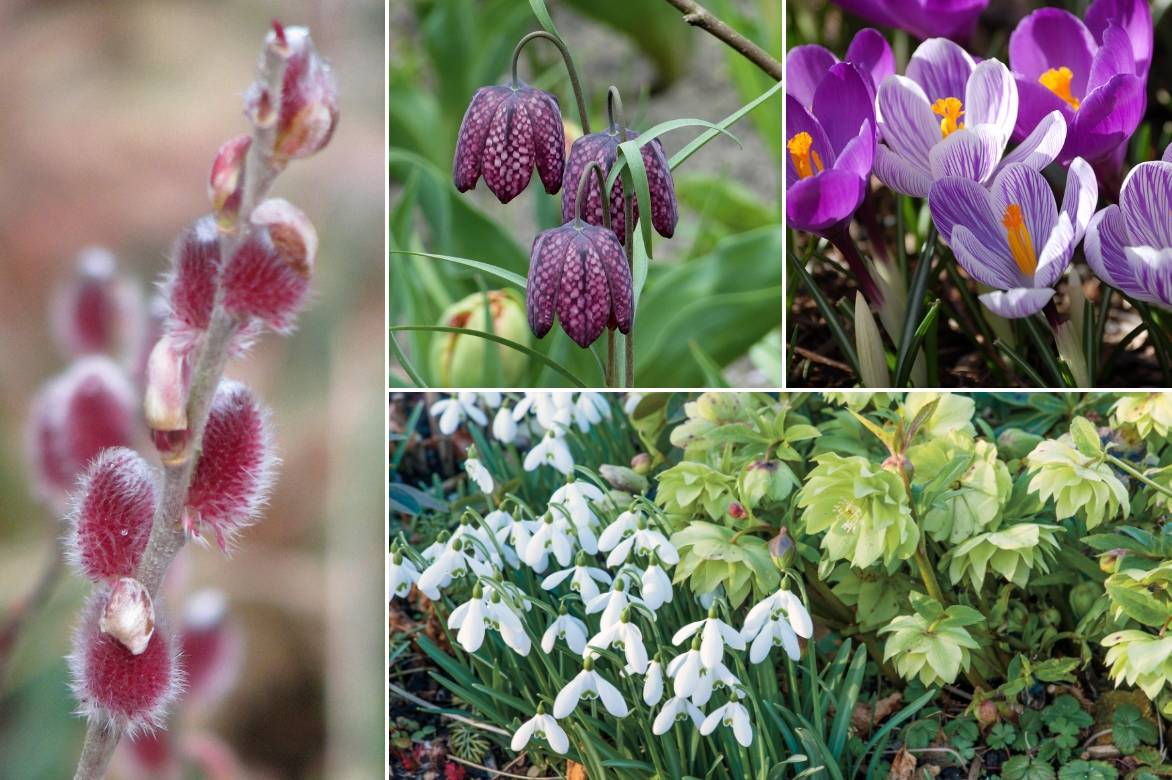
An example of a spring association: Salix chaenomeloides ‘Mount Aso’, Fritillaria meleagris, Crocus, Galanthus nivalis, and Helleborus orientalis
→ Discover more ideas for pairing with willows in our advice sheet!
To go further
Discover:
-
- our wide range of willows
- our article: Wickerwork: the art of weaving plants
- advice sheet: How to make willow water?
- tutorial: How to make a living willow hut?
- advice sheet: How to plant and maintain a living willow hedge?
- tutorial: How to make a wicker plant support?
- Discover our advice sheet on weeping trees
- Discover February’s favourite willows from Olivier, and the Willow ‘Mount Aso’
- Our advice sheet: Willow-Salix, the most beautiful varieties
- Our advice sheet: Choosing a willow
- Find willow in How to heal with trees?
- Subscribe!
- Contents
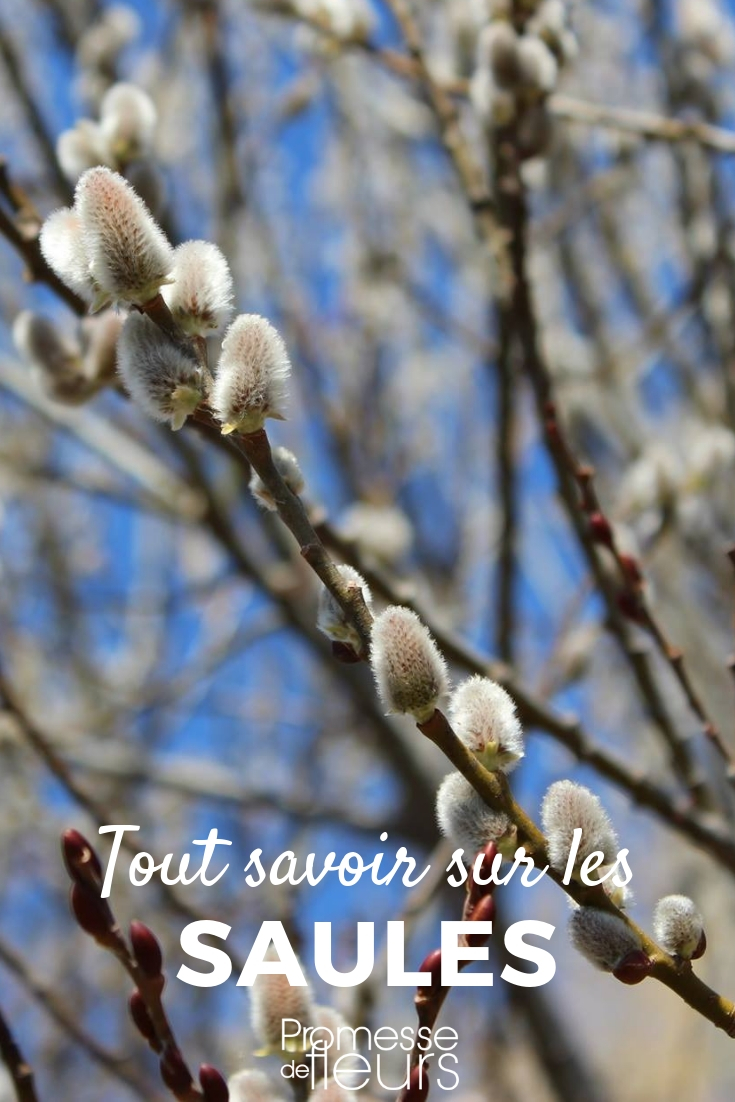































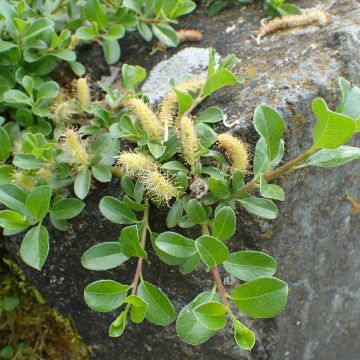
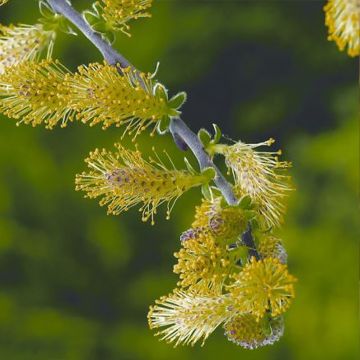

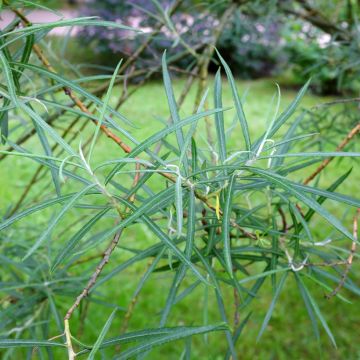
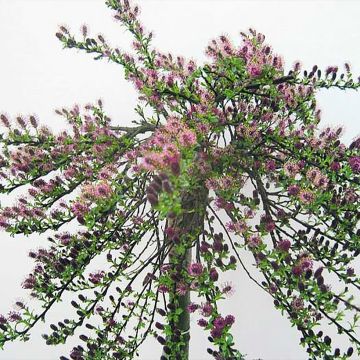
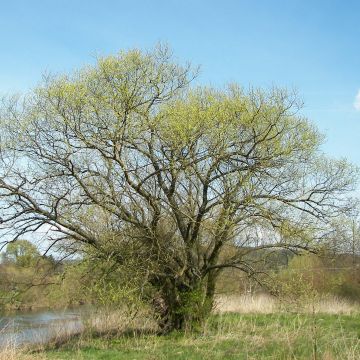

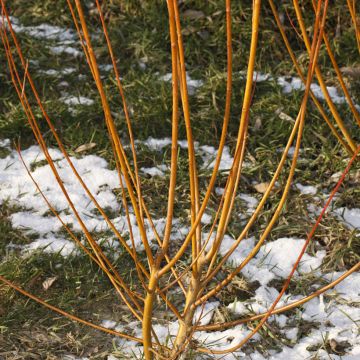

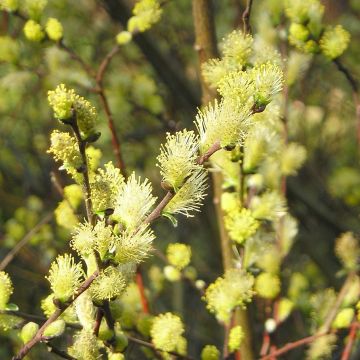
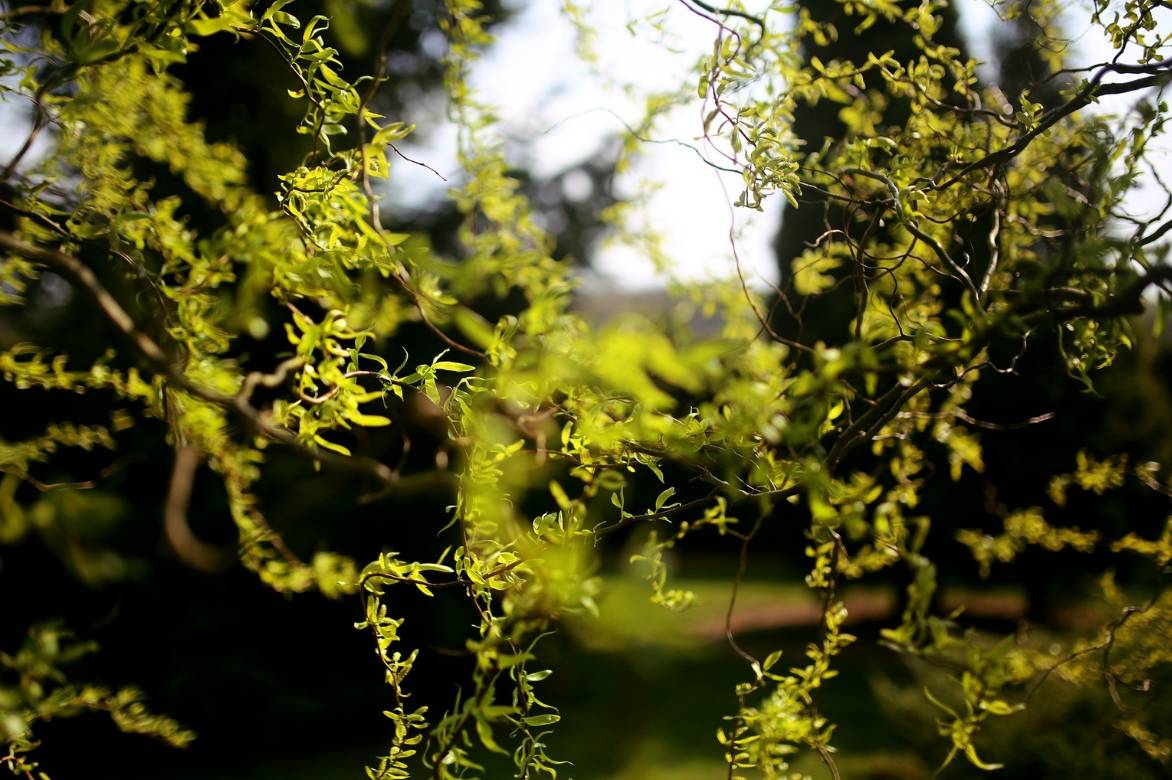
Comments